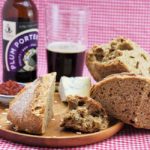
Beer & Cheese Bread with Oats
A hearty, rustic loaf that's full of flavour that's perfect for eating with cheeses, meats and pickles or alongside soups and stews.
Made using an easy, no-knead overnight method, instructions included for both instant dried yeast and sourdough starter.
Ingredients
- 80 g rolled oats
- 100 ml boiling water from a kettle
- 400 g white bread flour
- 100 g rye flour (optional: replace with any other flour you like)
- 100 g malthouse flour (optional: replace with any other flour you like)
- 2 tsp salt
- 80-100 g cheese, diced small see Recipe Notes for recommendations
- fine or coarse oatmeal (or extra flour) for dusting
For yeasted version
- 1.5 tsp quick, fast-acting dried yeast
- 460 ml dark beer see Recipe Notes for recommendations
For sourdough version
- 400 ml dark beer see Recipe Notes for recommendations
- 30 ml sourdough starter lively, refreshed approx 6 hours before
Instructions
The day before you want to bake the bread
-
Put the rolled oats in a bowl and pour over the boiling water. Stir and leave until completely cold.
-
Take a large bowl and add the flours. Stir in the salt.
Add the cold, soaked oats and rub them into the flour (as if you were making pastry) so that they're distributed throughout the flour.
-
For the yeasted version:
Stir in the dried yeast, then add all 460ml of the beer.
For the sourdough version:
Put the 400ml of beer in a jug then add the sourdough starter. Stir well to dissolve the starter.
Put the contents of the jug into the bowl containing the flour mixture.
-
Stir together to make a wet dough, ideally using a plastic or rubber spoon or spatula. Make sure everything is well combined.
Cover the bowl and leave overnight (12-16 hours).
The day of baking
-
The dough, still quite wet, should be well risen and very bubbly. Leave a little longer if necessary.
-
Scrape the dough out of its bowl and onto a worktop well dusted with oatmeal or flour.
If making 2 small instead of 1 large loaf, divide the dough in half now.
Fold the dough several times, keeping it well dusted with oatmeal or flour to prevent sticking, until it comes together into a smooth ball.
Flatten out the dough a little then sprinkle over the diced cheese. Fold it in half to cover the cheese, then keep folding until the cheese is distributed throughout the dough. Add more oatmeal or flour if needed to stop it sticking.
Shape the dough to roughly fit the proving basket(s) or tea towel-lined bowl(s).
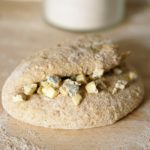
-
For the yeasted version:
Dust the proving basket(s) or tea towel(s) with oatmeal or flour and put the dough inside, smooth side down.
Cover and leave for around 30 min or until the depression left by a finger pressed into the dough slowly rather than quickly springs back.
For the sourdough version:
Cover and leave on the worktop to rest for 10 min.
Dust the proving basket(s) or tea towel(s) with oatmeal or flour and put the dough inside, smooth side down.
Cover and leave for 60-90 min or until the depression left by a finger pressed into the dough slowly rather than quickly springs back.
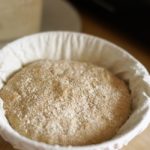
-
In the meantime: preheat the oven to its highest setting and put inside one or two cast iron pots or Dutch oven(s) including lids.
-
When ready to bake, remove the pot(s) from the oven and dust the inside with oatmeal or flour. Carefully flip the dough from the proving basket(s) or bowl(s) into the pot(s).
Slash the top(s), replace the lid(s) and place in the oven.
Immediately turn the heat down to 240C/220C Fan/Gas 9.
Bake for 30 minutes without removing the lid(s).
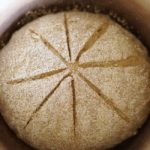
-
After 30 minutes, reduce the heat to 220C/200C Fan/Gas 7.
Remove the pot(s) from the oven, take the bread(s) out, then return to sit directly on the oven shelf. Bake for a further 10-15 minutes until the bread is cooked through (should sound hollow when tapped underneath).
If necessary, reduce the oven temperature to stop the crust over browning before the bread is finished baking.
-
Place on a wire rack to cool before eating.
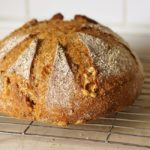
Recipe Notes
I use local Dovedale Blue cheese from the Staffordshire Cheese Company in this recipe, but other cheeses can be used, so pick your favourite. You can also increase the amount of cheese.
I recommend a dark, strong flavoured beer for the best results. I use Plum Porter from Titanic Brewery in Stoke-on-Trent and love the fruity hints it brings as well.